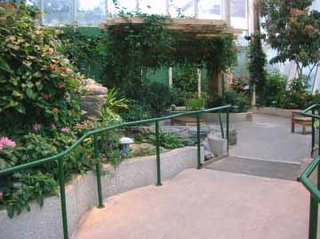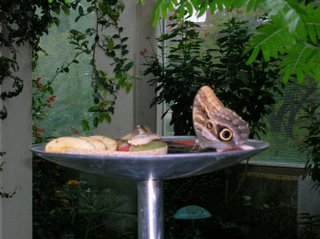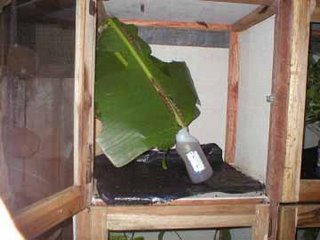Butterflies Under Glass


The main reason that I was hired to be curator at my museum was to run a display of living butterflies. The main reason that I accepted the job was to be able to do some of the conservation work that I have blogged about previously. But running the butterfly exhibit is something that I have genuinely enjoyed. The exhibit is a greenhouse, where we grow a variety of flowering plants that our butterflies use as nectar sources. People can walk around inside the greenhouse among the free-flying butterflies. This type of exhibit is becoming increasingly popular around the world. In the US, there are over a dozen large exhibits in a number of cities including Houston, Denver, Key West, St. Louis, and ours in Chicago. We fly our butterflies year round, and I especially enjoy going into the exhibit before we open on days that it’s snowing outside. I have the place to myself, and I enjoy the contrast of tropical plants and butterflies from around the world with the winter scene just a few feet away.

Exhibit Lab. The chrysalides are in the styrofoam box on the counter.
There are butterflies from about a dozen countries, including Costa Rica, Ecuador, Kenya, and Malaysia. We purchase all of our butterflies as chrysalides, mainly because that’s the easiest life stage to ship. The chrysalises arrive in very ordinary looking styrofoam boxes, and are unpacked in a laboratory. We hang them on foam-backed boards, and place them in a sealed case. In a few days to a few weeks, the adult butterflies emerge and are released into the exhibit.

Owl butterfly from Costa Rica feeding on fruit
The butterflies are actually raised on farms in the various countries where we purchase them. The farmers have simpler versions of our exhibit space where they allow the adult butterflies to mate and lay eggs. They put in a great deal of effort growing the kinds of plants that the caterpillars eat, and feeding and caring for the larvae. Once the caterpillars pupate, they are transported to central distribution centers, sorted and boxed, and shipped to people like me.

Butterfly eggs and chrysalides on a farm near San Jose in Costa Rica

Rearing owl butterfly caterpillars on banana leaves. Guacimo, Costa Rica.
Butterfly exhibits like ours are very popular, and likely to be a permanent feature of the zoo/aquarium/museum landscape. It’s a lot of fun working in this field right now, because the technology is still fairly new, and so we are still developing new methods to improve butterfly display. New species are being developed for exhibition every year. It’s also rewarding, because the industry provides a needed infusion of cash to countries in the developing world, and has some other environmental benefits.

Doug with butterfly farmers in Costa Rica
A couple of years ago, I took a butterfly farming seminar in Costa Rica. One family proudly showed us their agricultural fields. There were two small ones, one to grow nectar plants and one to grow host plants for the caterpillars. The largest- many hectares in size- was a block of intact rainforest that they would periodically harvest small numbers of butterflies from for breeding. It was more economically viable for them to use the land that way than to clear it for a coffee or banana plantation.

Life on the butterfly farm. Guacimo, Costa Rica
Labels: Butterflies, Museum


9 Comments:
I watched this french film today in my french class about a man who collects butterflies. He did some of the things you described and I found it absolutely fascinating. Butterflies are such beautiful creatures.
so that is costa rica?
What a neat way to see a bit of Costa Rico! I just love the idea of a living butterfly museum. I can only imagine that if you get enough of them flying around in the green house/atrium that it probably is beautiful. I like living displays.... things like walk-thru aviaries, etc.
Those are huge caterpillars! What a great way to help preserve the rainforests.
Thanks to all for the nice comments.
Tony- I took the picture inside of the exhibit late in the day, when most of the butterflies were settled down for the night. You are right, having enough of them up and flying can make or break the exhibit.
Rodger- The owl butterfly caterpillars in that picture are not even full grown. But then, they turn into a huge butterfly. The adult is the species with the eye spot that is pictured on the fruit tray. I'm noticing that the fruit doesn't show up well to give a sense of scale. The adults can be more than 8" across. There is a huge swallowtail butterfly from Jamaica with caterpillars that can weigh as much as a mouse.
*wondering how long it would take to drive to Chicago*
I read somewhere there is a butterfly exhibit in New York about a year ago and I have been bugging my husband since. I think that is so cool!
Post more pictures!!!!!
What a hypnotic blog post and ability to create that desire to "be there". Doug, thank you, I wish we were going to STOP in Chicago on our trip to see your creation. Here in Oregon, we have a cheap fakey Butterfly "garden" (that's what they call it) in coast tourist town Seaside, and it does nothing for nature. I probably have missed some research on your page, but is your beautiful live collection part of the big Field Museum?
Ah. Lepidoptera alive!
Do they have moth exhibits too?
BID- There is a butterfly exhibit at the American Museum of Natural History in NYC. It's seasonal, and only runs during the winter months. I believe it opened for the year this past weekend. Your profile says you are in PA. If you are in the western part of the state, there is also a very nice one in Cleveland.
Mark- There is also a butterfly exhibit at the Portland Zoo (or at least there was until recently. I don't know if they are still doing it). My friend Mary Jo looks after it. It's also a seasonal exhibit, but runs in the summer. New York is a bit of an anomaly. Most of the butterfly exhibits either run year round or during the summer. I'm not with the Field Museum. I work at the Nature Museum (www.naturemuseum.org) on the north side.
Homer- I don't think that there are any exhibits of just moths, but a lot of butterfly exhibits show some. We sometimes fly Atlas moths. They're amazing- they can get up to a foot in wingspan. We don't have any at the moment, and I don't have a photo, but I'll post one the next time we get a shipment.
Post a Comment
<< Home